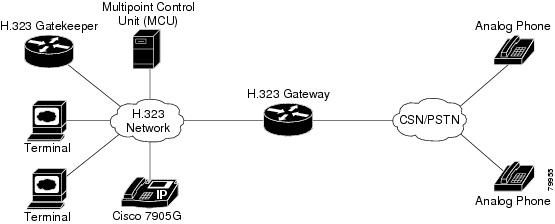

-
Cisco IP Phone 7905G Administration Guide for H.323
-
Index
-
Preface
-
Cisco IP Phone 7905G for H.323 Overview
-
Installing the Cisco IP Phone 7905G for H.323
-
Configuring the Cisco IP Phone 7905G
-
Troubleshooting the Cisco IP Phone 7905G
-
Upgrading Software on the Cisco IP Phone 7905G
-
Parameters and Defaults for Cisco IP Phone 7905G
-
Specifications for the Cisco IP Phone 7905G
-
Glossary
-
Table Of Contents
Cisco IP Phone 7905G for H.323 Overview
Cisco IP Phone 7905G for H.323 Overview
This chapter describes the hardware and software features of Cisco IP Phone 7905G and provides a brief overview of H.323 protocol. It contains the following sections:
Introduction
The Cisco IP Phone 7905G is a cost-effective, entry-level, single-line telephone that operates on IP-based telephony networks. It provides access to IP telephony applications and makes use of broadband bandwidth that are available with digital subscriber line (DSL), fixed wireless, cable modems, and other Ethernet connections. The Cisco IP Phone 7905G is easily installed by an end user.
Hardware Overview
The Cisco IP Phone 7905G is a compact, easy-to-install device that can function as a desk unit or be mounted on a wall. Figure 1-1 shows the Cisco IP Phone 7905G.
Figure 1-1 Cisco IP Phone 7905G
The unit provides the following connectors and indicators:
•
Handset
•
Switch hook
•
Ringer with LED
•
12-key dial pad
•
Speaker
•
Volume toggle
•
Vertical scroll navigation toggle
•
2 backlit LED hard keys, for Hold and Services
•
4 soft-key buttons
•
Monochrome (black/white) 192x64 resolution LCD display
•
RJ-45 10BASE-T Ethernet port—To connect the phone to a 10/100BASE-T hub or another Ethernet device
Software Features
The Cisco IP Phone 7905G supports the following software features:
Protocols
The Cisco IP Phone 7905G supports the following protocols:
•
Cisco Discovery Protocol (CDP)
•
Domain Name System (DNS)
•
Dynamic Host Configuration Protocol (DHCP)
•
H.323
•
Internet Control Message Protocol (ICMP)
•
Internet Protocol (IP)
•
Real-Time Transport Protocol (RTP)
•
Simple Network Time Protocol (SNTP)
•
Transmission Control Protocol (TCP)
•
Trivial File Transfer Protocol (TFTP)
•
User Datagram Protocol (UDP)
Basic Services
The Cisco IP Phone 7905G supports the following basic services.
•
Provisioning through LCD screen menus, TFTP server, or web browser
•
IP address assignment—DHCP or manual static IP address
•
Configurable Type of Service (ToS) bit for Quality of Service (QoS)
•
Configurable ring
•
Configurable tone (dial tone, ringback tone, busy tone, alert tone, reorder tone)
•
G.711 u-law and A-law support
•
Voice-activity-detection (VAD) and comfort-noise-generation (CNG) support for G.711 u-law and G.711 A-law, and support for G.729 Annex B
•
Out-of-band dual-tone multifrequency (DTMF) relay support
•
Dynamic jitter buffer for voice packets
Supplemental Services
The Cisco IP Phone 7905G supports the following supplemental services:
•
Call waiting support
•
Calling line ID presentation/rejection (CLIP/CLIR) support
•
Three-way calling support
•
Call hold support
H.323 Overview
H.323 is the International Telecommunication Union (ITU) standard for transmitting voice, video, and data across an IP network. Like other VoIP protocols, the H.323 standard is designed to address the functions of signaling and session management within a packet telephony network. Signaling allows call information to be carried across network boundaries. Session management provides the ability to control the attributes of an end-to-end call. The H.323 standard includes support for call signaling and control, multimedia transport and control, and bandwidth control for both point-to-point and point-to-multipoint conferences.
The H.323 standard consists of the following components and protocols:
•
Call signaling using the H.225 protocol
•
Media control using the H.245 protocol
•
G.711, G.722, G.723, G.728, and G.729 audio codecs
•
H.261 and H.263 video codecs
•
Data sharing using the T.120 protocol
•
Real-time transport protocol (RTP) and RTP Control Protocol (RTCP) for media transport
Components of H.323
The H.323 standard employs a system of interconnected voice terminals, gateways, gatekeepers, multipoint control units (MCUs), and proxy servers.
Voice terminals provide point-to-point and point-to-multipoint conference capability for audio, video, and data. Voice gateways interconnect the packetized IP network to the PSTN or ISDN network. Gatekeepers provide admission control and address translation services for H.323 voice terminals and gateways. MCUs enable two or more gateways to engage in point-to-point or point-to-multipoint audio or video conferences. Figure 1-2 shows the components in a H.323 system.
Note
The term conference refers to an established session (or call) between two or more endpoints (terminals). In this document, the terms conference and call are used interchangeably.
Figure 1-2 H.323 Architecture
H.323 Terminals
In the context of an H.323 network, voice terminals must feature system control units, media transmission capabilities, audio codecs, and network interfaces suitable for transmitting and receiving packetized data.
H.323 Gateways
H.323 gateways have characteristics of both standard Switched Circuit Network (SCN) access points and H.323 access points. Gateways handle the translation of audio, video, and data transmission formats as well as communications systems and protocols. The primary responsibility of H.323 gateway is to perform call setup and teardown operations between packetized IP networks and standard switched networks.
Note
Gateways are only necessary in H.323 systems where calls must connect over both packetized IP networks and switched circuit networks like the PSTN.
H.323 Gatekeepers
Gatekeepers are primarily responsible for pre-call and call-level control services for H.323 gateways. Gatekeepers are optional components in H.323 systems, When gatekeepers are used in a system, they perform the following call setup and management services:
•
Address translation for IP addresses originating from H.323 aliases (address_pool@cisco.com, for example) or E.164 addresses (e.g., standard telephone numbers)
•
Admissions control for authorizing or rejecting access to a H.323 zone.
•
Bandwidth control for gateway bandwidth requirements
•
Zone management for registered voice terminals, gateways and MCUs
Gatekeepers can also provide the following optional functionality:
•
Call control signaling using the gatekeeper Routed Call Signaling model
•
Call authorization to restrict access to certain voice terminals or gateways or to restrict access based on time-of-day criteria
•
Bandwidth management for the H.323 system that will enable the gateway to restrict access when requested bandwidth is unavailable
•
Call management including maintaining a list of active calls you can use to indicate available and unavailable voice terminals and gateways
H.323 MCUs
MCUs are endpoints in H.323 networks that support point-to-multipoint conferences. Each MCU consists of a multipoint controller and at least one multipoint processor responsible for receiving voice, video, and data streams. These streams are distributed to access points participating in a point-to-multipoint conference.
H.323 Proxy Server
An H.323 proxy server is a proxy specifically designed for the H.323 protocol that examines packets between two communicating applications. Proxies are able to determine the destination of a call and perform call-connection steps, if necessary.
H.323 proxies perform the following key functions:
•
Voice terminals that do not support Resource Reservation Protocol (RSVP) can connect through remote access or local area networks (LANs) with relatively reliable quality of service (QoS) to the proxy. Pairs of proxies can then be employed to develop tunnels across the IP network.
•
Proxies support routing H.323 traffic separately from ordinary data traffic using application-specific routing (ASR).
•
Proxies are compatible with network address translation functions in gateways or gatekeepers, enabling H.323 to be deployed in networks using private address space.
You can use an H.323 proxy to help ensure network security by configuring the proxy server to allow only H.323 traffic over the network.

 Feedback
Feedback

